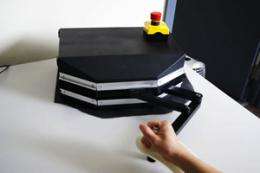Intelligent, affordable rehab robot to help stroke patients

Rehabilitation is crucial after a stroke. Yet patients don’t always do their exercises because they’re boring or difficult to do at home.
But what if you could make them easy and fun?
Enter University of Toronto Associate Professor Alex Mihailidis and his intelligent, table-top robot.
"This new robot will help to advance the use of robotics in stroke rehab," said Mihailidis, “as it will provide an affordable and accessible technology that can be used in hospitals, clinics, and in the home.”
Mihailidis, of U of T’s Institute of Biomaterials and Biomedical Engineering (IBBME) knows the speed and intensity by which stroke patients begin rehabilitation exercises greatly increases patients' neuroplasticity—the brain's ability to reorganize itself around damaged areas by forming new neural connections—and mobility. But rehab exercises are often neglected in a home environment, either because those exercises are repetitive and boring, or because attendants and rehab machines are needed to oversee or complete the exercises.
With his team of researchers, Mihailidis, the Barbara G. Stymiest Research Chair in Rehabilitation Technology at the Toronto Rehabilitation Institute, used interviews with focus groups and therapists, along with questionnaires from more 200 respondents to design a new, more cost-effective rehabilitation robot. Working with industrial partner Quanser Consulting Inc., they developed a lightweight, portable robot. Approximately one-tenth the cost of rehab robots currently available, the robot is designed to go home with patients.
And it’s intelligent.
"The fact that it can automatically learn about a user and adapt its exercises accordingly makes this robot unique," Mihailidis said.
Patients interact with games and other visual stimuli displayed on a computer screen as part of their exercises, making these repetitive movements fun and interactive. Meanwhile, the robot's artificial intelligence, an integral part of its design, allows the robot to operate independently, tracking a patient's progress and recalling how the patient did during previous sessions. It adjusts the difficulty of the exercises according to the user's needs and fatigue-level, while a camera system—also a unique characteristic—records patients' posture and movements.
IBBME post-doctoral researcher Rajibul Huq, designer of the robotic intelligence, explained that "the system can record video or any other data" that attendants can then access remotely.
The rehab robot technology may also help patients suffering from spinal cord and brain injuries, osteoarthritis, or address other types of upper body rehabilitation needs. A second round of clinical trials of the robot is scheduled to begin next month, with the goal of distributing the technology by early autumn.
Provided by University of Toronto


















